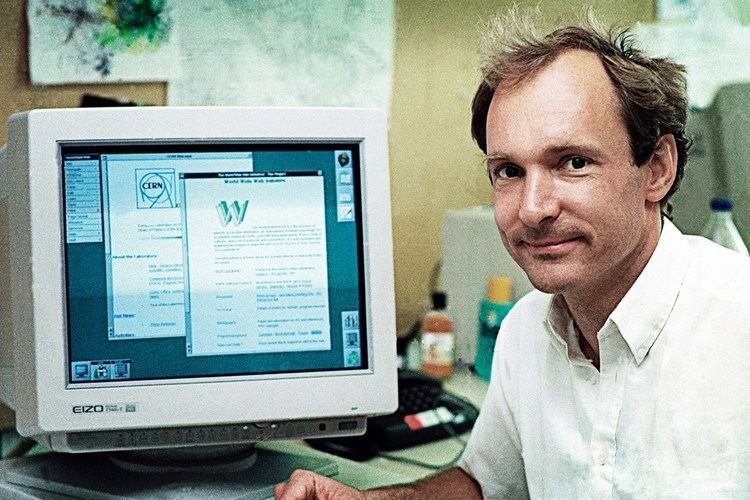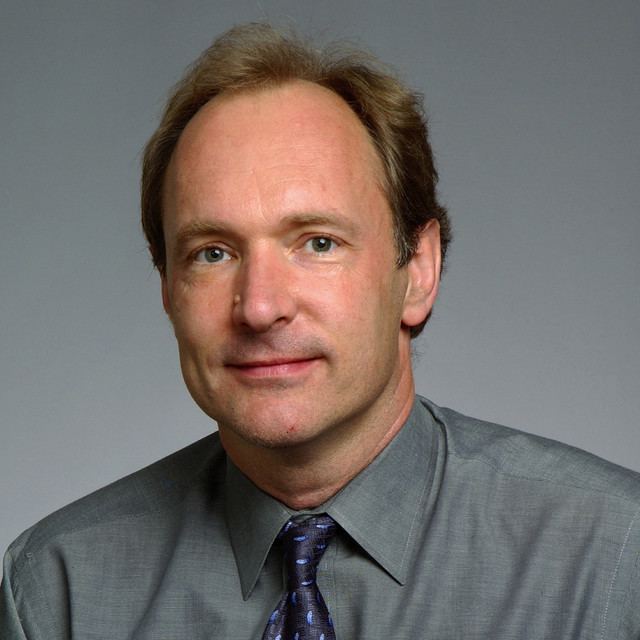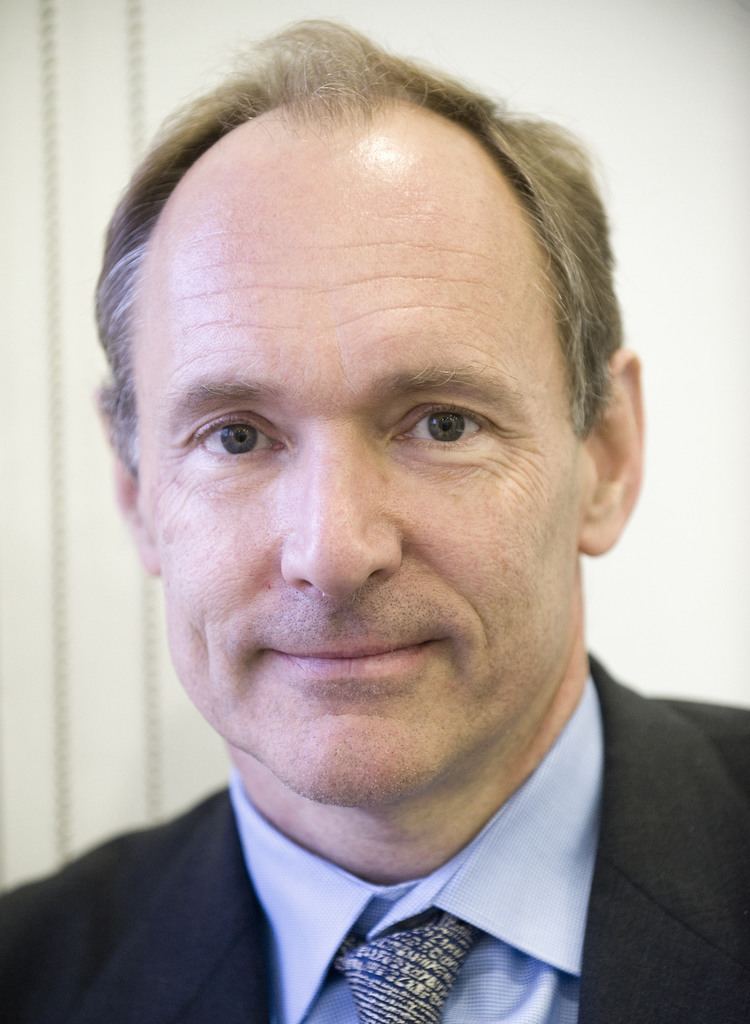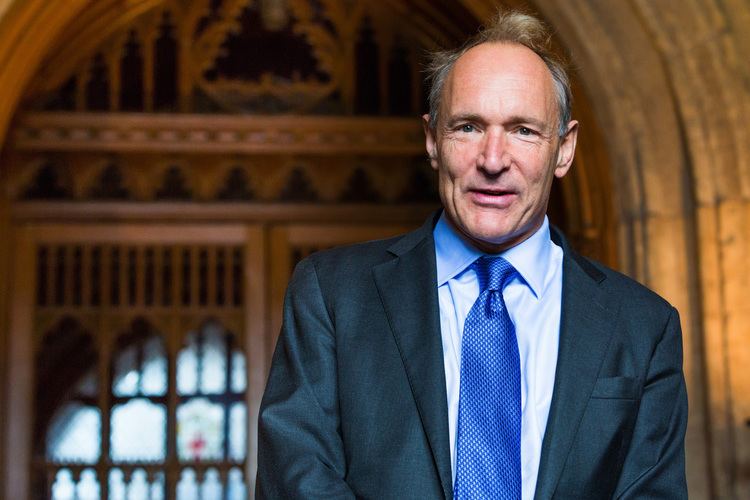Name Tim Berners-Lee | Role Computer scientist | |
 | ||
Notable awards OM (2007)KBE (2004)FRS (2001)FREngFRSADFBCS (1995)See full list of honours Spouse Nancy Carlson (m. 1990) (divorced)Rosemary Leith (m. 2014) Awards MacArthur Fellowship, Marconi Prize, Mountbatten Medal Parents Mary Lee Woods, Conway Berners-Lee Books Weaving the Web: The Origi, A Framework for Web S, Leaders in Computing: Changing, Foundations and Trends: A Similar People Robert Cailliau, Steve Jobs, Charles Babbage, Vint Cerf, Aaron Swartz Profiles | ||
Sir Tim Berners Lee, Inventor of the World Wide Web. First Internet Connection 1990.
Tim Berners Lee Biography | Tim Berners Lee English Computer Scientist| Tim Berners Lee
Sir Timothy John Berners-Lee OM KBE FRS FREng FRSA FBCS (born 8 June 1955), also known as TimBL, is an English engineer and computer scientist, best known as the inventor of the World Wide Web. He made a proposal for an information management system in March 1989, and he implemented the first successful communication between a Hypertext Transfer Protocol (HTTP) client and server via the internet in mid-November the same year.
Contents
- Sir Tim Berners Lee Inventor of the World Wide Web First Internet Connection 1990
- Tim Berners Lee Biography Tim Berners Lee English Computer Scientist Tim Berners Lee
- Early life and education
- Career
- Recent work
- Awards and honours
- Personal life
- References

Berners-Lee is the director of the World Wide Web Consortium (W3C), which oversees the continued development of the Web. He is also the founder of the World Wide Web Foundation and is a senior researcher and holder of the founders chair at the MIT Computer Science and Artificial Intelligence Laboratory (CSAIL). He is a director of the Web Science Research Initiative (WSRI), and a member of the advisory board of the MIT Center for Collective Intelligence. In 2011, he was named as a member of the board of trustees of the Ford Foundation.

In 2004, Berners-Lee was knighted by Queen Elizabeth II for his pioneering work. In April 2009, he was elected a foreign associate of the United States National Academy of Sciences. Named in Time magazine's list of the 100 Most Important People of the 20th century, Berners-Lee has received a number of other accolades for his invention. He was honoured as the "Inventor of the World Wide Web" during the 2012 Summer Olympics opening ceremony, in which he appeared in person, working with a vintage NeXT Computer at the London Olympic Stadium. He tweeted "This is for everyone", which instantly was spelled out in LCD lights attached to the chairs of the 80,000 people in the audience. Berners-Lee received the 2016 Turing Award "for inventing the World Wide Web, the first web browser, and the fundamental protocols and algorithms allowing the Web to scale".

Early life and education

Berners-Lee was born in London, England, United Kingdom, one of four children born to Mary Lee Woods and Conway Berners-Lee. His parents worked on the first commercially built computer, the Ferranti Mark 1. He attended Sheen Mount Primary School, and then went on to attend south west London's Emanuel School from 1969 to 1973, at the time a direct grant grammar school, which became an independent school in 1975. A keen trainspotter as a child, he learnt about electronics from tinkering with a model railway. He studied at The Queen's College, Oxford, from 1973 to 1976, where he received a first-class bachelor of arts degree in physics.
Career

After graduation, Berners-Lee worked as an engineer at the telecommunications company Plessey in Poole, Dorset. In 1978, he joined D. G. Nash in Ferndown, Dorset, where he helped create type-setting software for printers.
Berners-Lee worked as an independent contractor at CERN from June to December 1980. While in Geneva, he proposed a project based on the concept of hypertext, to facilitate sharing and updating information among researchers. To demonstrate it, he built a prototype system named ENQUIRE.
After leaving CERN in late 1980, he went to work at John Poole's Image Computer Systems, Ltd, in Bournemouth, Dorset. He ran the company's technical side for three years. The project he worked on was a "real-time remote procedure call" which gave him experience in computer networking. In 1984, he returned to CERN as a fellow.
In 1989, CERN was the largest internet node in Europe, and Berners-Lee saw an opportunity to join hypertext with the internet:
"I just had to take the hypertext idea and connect it to the Transmission Control Protocol and domain name system ideas and—ta-da!—the World Wide Web ... Creating the web was really an act of desperation, because the situation without it was very difficult when I was working at CERN later. Most of the technology involved in the web, like the hypertext, like the internet, multifont text objects, had all been designed already. I just had to put them together. It was a step of generalising, going to a higher level of abstraction, thinking about all the documentation systems out there as being possibly part of a larger imaginary documentation system."
Berners-Lee wrote his proposal in March 1989 and, in 1990, redistributed it. It then was accepted by his manager, Mike Sendall. He used similar ideas to those underlying the ENQUIRE system to create the World Wide Web, for which he designed and built the first Web browser. His software also functioned as an editor (called WorldWideWeb, running on the NeXTSTEP operating system), and the first Web server, CERN HTTPd (short for Hypertext Transfer Protocol daemon).
"Mike Sendall buys a NeXT cube for evaluation, and gives it to Tim [Berners-Lee]. Tim's prototype implementation on NeXTStep is made in the space of a few months, thanks to the qualities of the NeXTStep software development system. This prototype offers WYSIWYG browsing/authoring! Current Web browsers used in 'surfing the internet' are mere passive windows, depriving the user of the possibility to contribute. During some sessions in the CERN cafeteria, Tim and I try to find a catching name for the system. I was determined that the name should not yet again be taken from Greek mythology..... Tim proposes 'World-Wide Web'. I like this very much, except that it is difficult to pronounce in French..." by Robert Cailliau, 2 November 1995.
The first web site was built at CERN. Despite this being an international organisation hosted by Switzerland, the office that Berners-Lee used was just across the border in France. It was put online on 6 August 1991 for the first time:
info.cern.ch was the address of the world's first-ever web site and web server, running on a NeXT computer at CERN. The first web page address was http://info.cern.ch/hypertext/WWW/TheProject.html, which centred on information regarding the WWW project. Visitors could learn more about hypertext, technical details for creating their own webpage, and even an explanation on how to search the Web for information. There are no screenshots of this original page and, in any case, changes were made daily to the information available on the page as the WWW project developed. You may find a later copy (1992) on the World Wide Web Consortium website.
It provided an explanation of what the World Wide Web was, and how one could use a browser and set up a web server. In a list of 80 cultural moments that shaped the world, chosen by a panel of 25 eminent scientists, academics, writers, and world leaders, the invention of the World Wide Web was ranked number one, with the entry stating, "The fastest growing communications medium of all time, the internet has changed the shape of modern life forever. We can connect with each other instantly, all over the world".
In 1994, Berners-Lee founded the W3C at the Massachusetts Institute of Technology. It comprised various companies that were willing to create standards and recommendations to improve the quality of the Web. Berners-Lee made his idea available freely, with no patent and no royalties due. The World Wide Web Consortium decided that its standards should be based on royalty-free technology, so that they easily could be adopted by anyone.
In 2001, Berners-Lee became a patron of the East Dorset Heritage Trust, having previously lived in Colehill in Wimborne, East Dorset. In December 2004, he accepted a chair in computer science at the School of Electronics and Computer Science, University of Southampton, Hampshire, to work on the Semantic Web.
In a Times article in October 2009, Berners-Lee admitted that the initial pair of slashes ("//") in a web address were "unnecessary". He told the newspaper that he easily could have designed web addresses without the slashes. "There you go, it seemed like a good idea at the time", he said in his lighthearted apology.
Recent work
In June 2009, then-British Prime Minister Gordon Brown announced Berners-Lee would work with the UK government to help make data more open and accessible on the Web, building on the work of the Power of Information Task Force. Berners-Lee and Professor Nigel Shadbolt are the two key figures behind data.gov.uk, a UK government project to open up almost all data acquired for official purposes for free re-use. Commenting on the opening up of Ordnance Survey data in April 2010, Berners-Lee said that: "The changes signal a wider cultural change in government based on an assumption that information should be in the public domain unless there is a good reason not to—not the other way around." He went on to say: "Greater openness, accountability and transparency in Government will give people greater choice and make it easier for individuals to get more directly involved in issues that matter to them."
In November 2009, Berners-Lee launched the World Wide Web Foundation in order to "advance the Web to empower humanity by launching transformative programs that build local capacity to leverage the Web as a medium for positive change."
Berners-Lee is one of the pioneer voices in favour of net neutrality, and has expressed the view that ISPs should supply "connectivity with no strings attached", and should neither control nor monitor the browsing activities of customers without their expressed consent. He advocates the idea that net neutrality is a kind of human network right: "Threats to the internet, such as companies or governments that interfere with or snoop on internet traffic, compromise basic human network rights."
Berners-Lee joined the board of advisors of start-up State.com, based in London. As of May 2012, Berners-Lee is president of the Open Data Institute.
The Alliance for Affordable Internet (A4AI) was launched in October 2013 and Berners-Lee is leading the coalition of public and private organisations that includes Google, Facebook, Intel, and Microsoft. The A4AI seeks to make internet access more affordable so that access is broadened in the developing world, where only 31% of people are online. Berners-Lee will work with those aiming to decrease internet access prices so that they fall below the UN Broadband Commission's worldwide target of 5% of monthly income.
Berners-Lee holds the founders chair in Computer Science at the Massachusetts Institute of Technology, where he heads the Decentralized Information Group and is leading Solid, a joint project with the Qatar Computing Research Institute that aims to radically change the way Web applications work today, resulting in true data ownership as well as improved privacy. In October 2016, he joined the Department of Computer Science at Oxford University as a professorial research fellow and as a fellow of Christ Church, one of the Oxford colleges.
Awards and honours
Berners-Lee has received many awards and honours. He was knighted in 2004 upon promotion from Officer of the Order of the British Empire (OBE) to Knight Commander of the Order of the British Empire (KBE) in the New Year Honours "for services to the global development of the internet", and was invested formally on 16 July 2004.
On 13 June 2007, he was appointed to the Order of Merit (OM), an order restricted to 24 (living) members. Bestowing membership of the Order of Merit is within the personal purview of the Queen, and does not require recommendation by ministers or the Prime Minister. He was elected a Fellow of the Royal Society (FRS) in 2001. He has been conferred honorary degrees from a number of Universities around the world, including Manchester (his parents worked on the Manchester Mark 1 in the 1940s), Harvard and Yale.
In 2012, Berners-Lee was among the British cultural icons selected by artist Sir Peter Blake to appear in a new version of his most famous artwork – the Beatles' Sgt. Pepper's Lonely Hearts Club Band album cover – to celebrate the British cultural figures of his life that he most admires to mark his 80th birthday. On 4 April 2017, the Association for Computing Machinery named Berners-Lee the recipient of the 2016 Turing Award "for inventing the World Wide Web, the first web browser, and the fundamental protocols and algorithms allowing the Web to scale".
Personal life
Berners-Lee was married to Nancy Carlson in 1990; they had two children and divorced in 2011. In 2014, Berners-Lee married Rosemary Leith at St. James's Palace in London. Leith is director of the World Wide Web Foundation and a fellow at Harvard University's Berkman Center. Previously, she was World Economic Forum Global Agenda Council Chair of the Future of Internet Security and now is on the board of YouGov.
Berners-Lee was raised as an Anglican, but in his youth, he turned away from religion. After he became a parent, he became a Unitarian Universalist (UU). He has stated: "Like many people, I had a religious upbringing which I rejected as a teenager... Like many people, I came back to religion when we had children". He and his wife wanted to teach spirituality to his children, and after hearing a Unitarian minister and visiting the UU Church, they opted for it. He is an active member of that church, to which he adheres because he perceives it as a tolerant and liberal belief. He has said: "I believe that much of the philosophy of life associated with many religions is much more sound than the dogma which comes along with it. So I do respect them."
